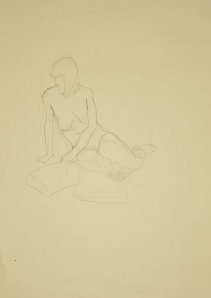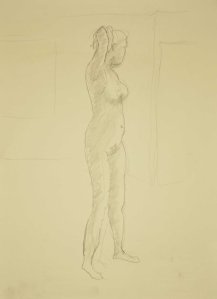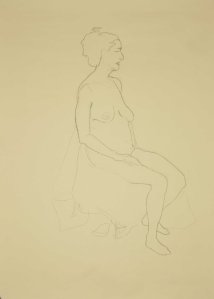DRAWING SKILLS
Part 5
Option 4
Exercise 3 Research point
Ingres
Ingres was perhaps the last of the great classical artists ,as a young man he spent a short time in David’s studios and was influenced by the drawings of the little known English artist John Flaxman (1755 -1826) who would later go on to achieve fame as the designer of the classical Jasperware for Sir Josiah Wedgewood.
Ingres’ drawings are line and not mass drawings they are not transformed from nature but are deliberately abstracted into a contour line and the main lines of the construction. This is precisely the information that Ingres required to carry out his academic paintings which are essentially coloured drawings built up in glazes.
The modelling in the drawings is completely suppressed Ingres was drawing the forms, there are no cast shadows even the heads in the drawings, which generally contain the darkest marks, Ingres was drawing the forms and not the light and shade he could see before him.
In the opinion of Pierre Rosenberg Ingres used his drawings as a self teaching aid to perfect his skills and whilst this may be true there is much evidence to show that Ingres would redraw a drawing in a slightly different position to improve the composition prior to commencing a painting. There is more modelling in Ingres’ paintings than in his pure line drawing, but there is still a dominance of line over shading. The lines that define Ingres’ painted forms are superior to the modelling.
Ingres instils the form in his drawings by two means, the first is by line weight Ingres uses a great variety of different line weights. Notice how the undersides of things in his drawings are bounded by a heavier line indicating that these are in shadow. A similar detail can be observed at folds in materials that are also in shadow. What modelling Ingres does carry out is done with soft shading probably done with the side of the pencil so as not to break up his large forms and turn his drawings from line drawings into mass drawings. This can readily be seen in the garments of Ingres drawings. Where sections of the clothing are in the light Ingres would use a soft contour almost as a lost edge.

Figure 1 (5.4.3 1) Ingres; Madame Victor Baltard. Note the subtle weighting and overlapping of line to achieve form in the cape and dress
The second technique Ingres used is to draw in short overlapping lines so that his contour lines were constantly cutting into his forms giving a stepped effect forcing parts of the form in front or behind each other. As in the first technique this enabled Ingres to show the modelling without resorting to shading which would clutter up the large forms in his line drawings.
Ingres drawings are in pencil and pencil works best as a line medium, Ingres used his skill in line work to express form that would more usually be carried out by shading.

Figure 2 (5.4.3.2) Ingres; La Grande Odalsque. the literal translation from the French is “woman with a long snakelike back”
Much is made these days of the exaggerated proportions in Ingres drawings and paintings. A classic example is the size of Julia’s arm in the drawing “The Forestier Family”. While such an error would have been corrected by Ingres prior to painting it is interesting to compare it to the back of “La Grande Odalisque where there appears to be more vertebrae than your average snake. Such distortion was probably carried out by Ingres for design purposes and unless such distortions is pointed out it is possible to look at “La Grande Odalisque” as a perfectly believable form, the beauty of the painting as a whole subjugates the anatomical error.

Figure 3 (5.4.3.3) Ingres; The Forestier Family. Ingres has captured Julia in her transformation into Octogirl, an early, little known, 19th century super hero.
Another problem with “The Forestier Family” is the inconsistency of the light source, this is probably because the drawing is an amalgam of separate portraits of the various members of the family.
Hockney in his theories as to the use of the camera Lucida by various artists concluded that Ingres used a camera Lucida for the clothing and then drew the heads from direct observation. It is probably the greatest good fortune that Mr Hockney earns his living as an artist rather than a scientist.
The additional finish to the faces in the drawings probably date from Ingres’ time earning his living drawing portraits of the great and the good doing the European tour when the faces had to be instantly recognisable to obtain payment. Take a trip to watch portrait artists at work in the cities today to observe this phenomenon.
Ingres’ heads despite appearing to be the more finished parts of his drawings are devoid of shading, Ingres achieves the modelling by careful positioning of the features and your brain fills in the missing bits.
By way of contrast to al this linear work there is an Ingres drawn head that has mush mure tonal work in it than one would normally associate with Ingres, this is the study for Vicomtesse Hausonville. Ingres seamed dissatisfied with the position of the Vicomtesse’s hand in the original sketch perhaps as he developed the design of the painting. The study was probably done in his studio as he painted the portrait. This is Ingres in paint mode which would probably account for the tonal work in the study, Below are the sketch, the Study and the finished painting I for one, perhaps two if you count Ingres, prefer the second version of the hand that was developed in the study.

Figure 4 (5.4.3.4) Ingres; Sketch for Vicomtesse. Ingres must have had his doubts about the position about the left hand from the beginning because of the heavy marks between the forefinger and chin, most unusual in an Ingres sketch.

Figure 5 (5.4.3.5) Ingres; Study for Vicomtesse Hausonville. Note the much more elegant arrangement of the left hand and the tonal work beneath her chin that transfers directly to the painting forcing the chin in front of the neck

Figure 6 (5.4.3.6) Ingres; Detail from Vicomtesse Hausonville. The painting that we all love and know of the good Vicomtesse with her ever so elegant left hand. Notice how the modeling in the painting is not as important as the line, why this could almost be a Jasperware portrait of the Vicomtesse.





















